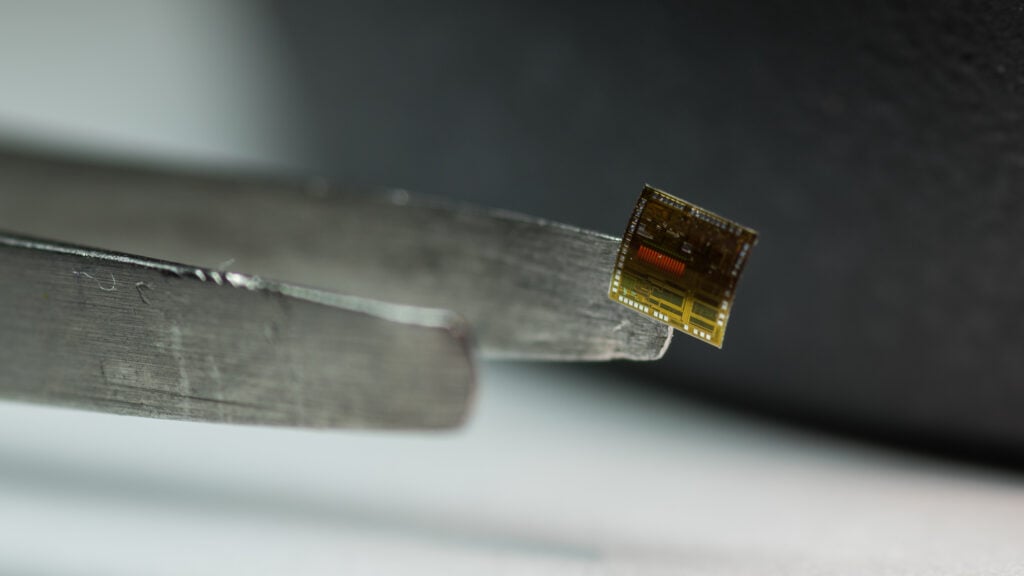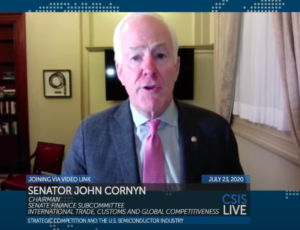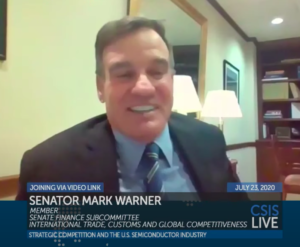
A microchip developed jointly by the Air Force Research Laboratory and American Semiconductor.
Perceiving a moment of acute national weakness, Senator John Cornyn reached across the aisle and proposed an action he described as at odds with his faith in the free market. If the United States was becoming increasingly dependent on Chinese manufacturers for semiconductors, what if the US government simply funded direct investment in the industrial capacity to build this crucial component of all modern electronics?
The answer, put forth by Cornyn, a Republican, and co-sponsored by Sen. Mark Warner, a Democrat, was the “Creating Helpful Incentives to Produce Semiconductors for America Act,” or the CHIPS For America Act. A version of the act passed the Senate last week as an amendment to the must-pass National Defense Authorization Act; a parallel version was introduced in the House in June as a standalone bill.

Sen. John Cornyn addresses the online CSIS event
At the heart of the amendment is a deep fear, one that transcends party lines, that if the United States does not actively invest in the industrial capacity needed to produce semiconductors at home, the nation will be held at the mercy of overseas manufacturers, particularly and explicitly those based in China.
“I think we all understand that China has moved up the list to the number-one rival of the United States, not only economically but they’re also acting very aggressively in their intelligence functions and in places like the South China Sea,” said Cornyn, speaking July 23rd at an CSIS event on Strategic Competition and the U.S. Semiconductor Industry.
“This is a little bit uncomfortable to some of us who were raised to believe in free markets and it would all work itself out,” said Cornyn. “But we all know now that the world is very different from perhaps those days and that if America is going to maintain our preeminence, not only from a national-security perspective but economically, a federal incentive program through the Department of Commerce to encourage semiconductor manufacturing is very important.”
Companies based inside the United States make up nearly half the global market share for these microchips, said Cornyn, before noting that the US, which once held a quarter of the chip manufacturing facilities, now only contains 12 percent of global manufacturing, relative to China currently manufacturing 16 percent of the world’s supply of microchips. More troubling to Cornyn was an estimate that, by 2030, “83 percent of the global semiconductor manufacturing will be in Asia.”
State investment in manufacturing — practiced by most countries as industrial policy but historically unpopular in the US — is largely responsible for China’s growth in this market. Cornyn cited investment policies by South Korea, Taiwan, Singapore, and Germany as how those countries are staying competitive in this space.
Underscoring the senators’ desire for American investment in semiconductors and microchips is a feeling that the United States is already playing catch-up on 5G. Warner compared it to a Sputnik moment, with the United States lagging behind a critical technology, both in producing it and creating rules to govern it.

Sen. Mark Warner addresses the CSIS event
“For so long, even if it was not invented in America, we — by our size, by our academic institutions — set the rules of procedure,” said Senator Warner at the CSIS event. “5G was the first time when, in many ways.. China flooded the zones in these international bodies to set the standards.”
As Warner sees it, the goal of federally funding a resurgent semiconductor manufacturing sector in the United States is about both building capacity and market position, from which the United States can then return to a strong position in setting international rules for commercial technology. Semiconductors may be the first top for this train, but Warner also specifically mentioned the same funding vehicle could be designed to support US industry in 5G, in artificial intelligence, in quantum computing, in hypersonics, and possibly elsewhere.
“We looked at different ways to do this and came up with this tax-incentive model, which we’re working with the Senate Finance Committee that Mark and I sit on as well,” said Cornyn. “Secretary Mnuchin’s got some other ideas. He said maybe if there’s some money left over in the – some of the COVID-19 relief package that hasn’t been able to be used for other purposes that maybe we could just use that money.”
Altogether, the amendment offers $10 billion in federal funding through the Department of Commerce, designed to be matched with state and local incentives. There are tax credits available for building manufacturing capacity in the next decade, with incentives scaling back after 2024 and ending in 2027. The CHIPs act amendment also sets aside $750 million to fund an international standards consortium.
“Industrial policy is called industrial policy because it means you’re advancing the interest of a nation-state,” said Warner. “And in this case it may not just be – and this is one of the things I’m excited about – not just an American industrial policy but, again, this coalition of the willing idea around a suite of technologies.”
Major trends and takeaways from the Defense Department’s Unfunded Priority Lists
Mark Cancian and Chris Park of CSIS break down what is in this year’s unfunded priority lists and what they say about the state of the US military.


























